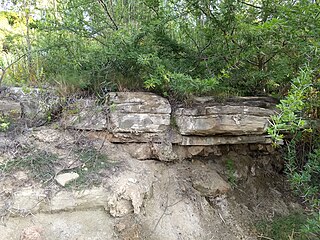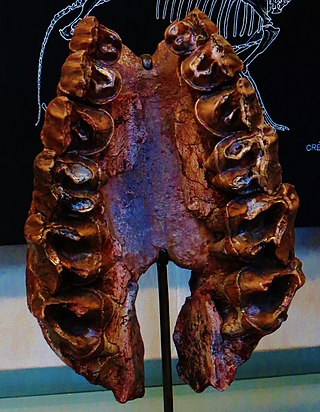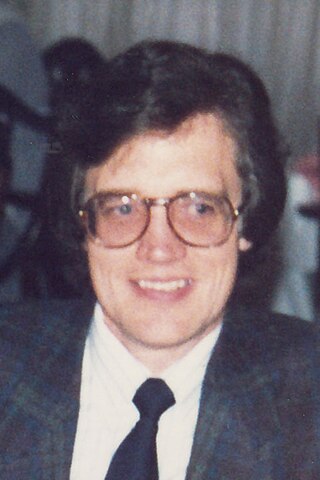
The Geological Society of London, known commonly as the Geological Society, is a learned society based in the United Kingdom. It is the oldest national geological society in the world and the largest in Europe, with more than 12,000 Fellows.

Micropaleontology is the branch of paleontology (palaeontology) that studies microfossils, or fossils that require the use of a microscope to see the organism, its morphology and its characteristic details.

A microfossil is a fossil that is generally between 0.001 mm and 1 mm in size, the visual study of which requires the use of light or electron microscopy. A fossil which can be studied with the naked eye or low-powered magnification, such as a hand lens, is referred to as a macrofossil.
The Danian is the oldest age or lowest stage of the Paleocene Epoch or Series, of the Paleogene Period or System, and of the Cenozoic Era or Erathem. The beginning of the Danian is at the Cretaceous–Paleogene extinction event 66 Ma. The age ended 61.6 Ma, being followed by the Selandian.
Katharina von Salis Perch-Nielsen is a Swiss geologist and orienteering competitor. She is a retired Adjunct Professor at the Department of Earth Sciences at ETH Zurich in Switzerland. She retired 1 October 2001. During her scientific career, as a Professor in the Micropaleontology at the Geological Institute at ETH Zurich, she was highly engaged in promoting gender equality in sciences and active in fighting to improve the position of girls and women in sciences at Swiss universities and high schools. She was at the origin of the Office of Equal Opportunities for Men and Women that exists at ETH Zurich since 1993.

The Sundays River Formation is a geological formation found in the Eastern and Western Cape provinces in South Africa. It is the second youngest of the four formations found within the Uitenhage Group of the Algoa Basin, its type locality, and the only location where outcrops have been located. The Sundays River has been measured at a maximum thickness of 2,000 metres (6,600 ft).

The Straight Cliffs Formation is a stratigraphic unit in the Kaiparowits Plateau of south central Utah. It is Late Cretaceous in age and contains fluvial, paralic, and marginal marine (shoreline) siliciclastic strata. It is well exposed around the margin of the Kaiparowits Plateau in the Grand Staircase – Escalante National Monument in south central Utah. The formation is named after the Straight Cliffs, a long band of cliffs creating the topographic feature Fiftymile Mountain.
The Britton Formation is a geologic formation deposited during the Middle Cenomanian to the Early Turonian ages of the Late Cretaceous in modern-day East Texas. It forms the lower half of the Eagle Ford Group in the northern portion of East Texas. The formation was named by W. L. Moreman in 1932 for outcrops on Mountain Creek near the small town of Britton, south of Dallas. In the Dallas area it has been subdivided into the Six Flags Limestone, Turner Park Member, and Camp Wisdom Member. The Six Flags Limestone is a 3 ft thick fossiliferous calcarenite made up of pieces (prisms) of Inoceramus clams. The Turner Park and Camp Wisdom Members were subdivided based on the numerous volcanic ash beds (bentonites) found in the Turner Park, and the common occurrence of concretions in the Camp Wisdom. They are approximately 120 ft and 250 ft thick in the Dallas area. Thin sandstones known as the Templeton Member are found in Grayson County, north of Dallas, that are age equivalent to the lower part of the Turner Park Member. The Templeton Member was originally described as a part of the Woodbine, but it was recently placed in the Britton Formation of the Eagle Ford Group based on its age as derived by ammonites. Plesiosaur remains are among the vertebrate fossils that have been recovered from its strata.
Leslie Rowsell Moore was a British geologist and Sorby Professor of Geology at the University of Sheffield, where under his leadership its geology department became one of the largest in the country. He also made significant advances in the study of palaeobotany and palynology. He was called as an expert witness at the inquiry into the Aberfan disaster. He was instrumental in the creation of the Micropalaeontological Society and was its first President. He has been described as "one of the founders of modern Carboniferous palynology".

The Yorktown Formation is a mapped bedrock unit in the Coastal Plain of Maryland, Virginia, North Carolina and South Carolina. It is overconsolidated and highly fossiliferous.
The Bouldnor Formation is a geological formation in the Hampshire Basin of southern England. It is the youngest formation of the Solent Group and was deposited during the uppermost Eocene and lower Oligocene.
The Favel Formation is a stratigraphic unit of Late Cretaceous age. It is present in southern Manitoba and southeastern Saskatchewan, and consists primarily of calcareous shale. It was named for the Favel River near Minitonas, Manitoba, by R.T.D. Wickenden in 1945.

Victor Standish Mallory was a micropaleontologist, biostratigrapher, Professor Emeritus at the University of Washington Department of Geology, and a Curator Emeritus of Invertebrate Paleontology at the Burke Museum of Natural History and Culture.
Ellen Thomas is a Dutch-born environmental scientist and geologist specializing in marine micropaleontology and paleoceanography. She is the emerita Harold T Stearns Professor and the Smith Curator of Paleontology of the Joe Webb Peoples Museum of Natural History at Wesleyan University, and a senior research scientist at Yale University.

Ronzotherium is an extinct genus of perissodactyl mammal from the family Rhinocerotidae. The name derives from the hill of 'Ronzon', the French locality near Le Puy-en-Velay at which it was first discovered, and the Greek suffix 'therium' meaning 'beast'. At present 5 species have been identified from several localities in Europe and Asia, spanning the Late Eocene to Upper Oligocene.

Dennis Curry was a British businessman, geologist and philanthropist. He was born into the family that owned and ran the Currys electrical goods retail chain, and took his place in the family business, rising to become its chairman.
Edith Kristan-Tollmann nee Edith Kristan was an Austrian geologist and paleontologist. A prolific scientist with an interest in micropalaeontology and especially the foraminifera of the Triassic and the Jurassic eras, Kristan-Tollmann published widely in her field. She is also known for originating with her husband Alexander Tollmann a thoroughly documented theory of the evolution of human legend and social structures as a result of a massive impact event which struck multiple points on earth. The latter has become known as Tollmann's hypothetical bolide.

David J. Batten (1943–2019) was a British palynologist. He is best known for his work in Mesozoic terrestrial palynology and palynofacies analysis. His specific contributions include work on the Normapolles group of pollen in the Late Cretaceous and Early Tertiary, Mesozoic and Tertiary megaspores from around the world, palynofacies analysis to interpret past environments, and the palynology of the Wealden Group of southern England.
Bridget S. Wade is a British micropalaeontologist who is a professor at the University College London. Her research considers Cenozoic climate change, which she investigates by studying preserved planktonic foraminifera. Wade was a guest on the 2020 Royal Institution Christmas Lectures.

Coalbrookdale Formation, earlier known as Wenlock Shale or Wenlock Shale Formation and also referred to as Herefordshire Lagerstätte in palaeontology, is a fossil-rich deposit (Konservat-Lagerstätte) in Powys and Herefordshire at the England–Wales border in UK. It belongs to the Wenlock Series of the Silurian Period within the Homerian Age. It is known for its well-preserved fossils of various invertebrate animals many of which are in their three-dimensional structures. Some of the fossils are regarded as earliest evidences and evolutionary origin of some of the major groups of modern animals.











